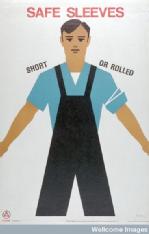Seminar 15: Is Work Good for Health?
 |
Work is by and large the lot of most people during their middle years, and, for much of the nineteenth and early twentieth centuries, also their youth and old age. But from the nineteenth century work has been seen as detrimental to health and wellbeing, notably in industrial towns and cities, and in the new dangerous environment of the factory, where it was associated with occupational diseases and accidents. Such experiences marked the working lives of many working men and women up until the increased focus on health and safety in post-war Britain. However, it has been argued that the work place – as well as the enhanced wages resulting from employment – could also be beneficial to health. |
Seminar Reading:
A.J. McIvor, ‘Manual Work, Technology, and Industrial Health, 1918-39’, Medical History, 31 (1987), 160-89. e-journal
Barbara Harrison, ‘“Some of them gets Lead Poisoned’’: Occupational Lead Exposure in Women, 1880-1914’, Social History of Medicine, 2 (1989), 171-95. e-journal
Vicky Long and Hilary Marland, ‘From Danger and Motherhood to Health and Beauty: Health Advice for the Factory Girl in Early Twentieth-Century Britain’, Twentieth Century British History, 20 (2009), 454-81. e-journal
Vicky Long, ‘“A satisfactory job is the best psychotherapist”: Employment and Mental Health, 1939-60’, in Joseph Melling and Pamela Dale (eds), Mental Illness and Learning Disability Since 1850: Finding a Place for Mental Disorder in the United Kingdom (London and New York: Routledge, 2006) OR Vicky Long, ‘Rethinking Post-war Mental Health Care: Industrial Therapy and the Chronic Mental Patient in Britain’, Social History of Medicine, 26 (2013),738-58 e-journal
Primary Sources
In preparation for this seminar visit the Modern Records Centre archives (online), and select and analyse a source on health and work.
Additional Reading:
Mel Bartley, Authorities and Partisans: The Debate on Unemployment and Health (Edinburgh: Edinburgh University Press, 1992).
Linda Bryder, ‘Tuberculosis, Silicosis and the Slate Industry in North Wales, 1827-1939’, in Paul Weindling (ed.), The Social History of Occupational Health (London: Croom Helm, 1985), 108-26.
M.L. Clark, Beyond the Reproductive Body: The Politics of Women’s Health and Work in Early Victorian England (Athens, OH: Ohio University Press, 2004).
Roger Cooter and Bill Luckin (eds), Accidents in History: Injuries, Fatalities and Social Relations (Amsterdam: Rodopi, 1997).
Pamela Dale, Janet Greenless and Joseph Melling, 'The Kiss of Death or a Flight of Fancy? Workers’ Health and the Press in the Campaign to Regulate Shuttle Kissing in the British Cotton Industry, c.1900-1946’, Social History, 32 (2007), 54-75. e-journal
Janet Greenlees, '“The dangers attending these conditions are evident”: Public Health and the Working Environment of Lancashire Textile Communities, c. 1870-1939', Social History of Medicine, 26 (2013), 672-94. e-journal
Barbara Harrison, ‘Not Only the Dangerous Trades’: Women’s Work and Health in Britain, 1880-1914 (London: Taylor & Francis, 1996).
Antonia Ineson and D. Thom, ‘TNT Poisoning and the Employment of Women Workers in the First World War’, in Paul Weindling (ed.), The Social History of Occupational Health (London: Croom Helm, 1985), 89-107.
Helen Jones, ‘Employers Welfare Schemes and Industrial relations in Inter-War Britain’, Business History, 25 (1983), 61-75. e-journal
Helen Jones, ‘Women Health Workers: The Case of the First Women Factory Inspectors in Britain’, Social History of Medicine, 1 (1998), 165-81. e-journal
Vicky Long, The Rise and Fall of the Healthy Factory: The Politics of Industrial Health in Britain, 1914–60 (Houndmills: Palgrave Macmillan, 2011). e-book
Vicky Long, ‘Industrial Homes, Domestic Factories: The Convergence of Public and Private Space in Interwar Britain’, Journal of British Studies, 50 (2011), 434-64. e-journal
Carolyn Malone, Women’s Bodies and the Dangerous Trades in England, 1880-1914 (Woodbridge: Boydell, 2003).
Arthur McIvor, 'Germs at Work: Establishing Tuberculosis as an Occupational Disease in Britain, c.1900-1951', Social History of Medicine, 25 (2012), 812-29. e -journal
Joseph Melling, 'An Inspector Calls: Perspectives on the History of Occupational Diseases and Accident Compensation in the United Kingdom', Medical History, 49 (2005), 102-06. e-journal
Joseph Melling, ‘Beyond a Shadow of a Doubt? Experts, Lay Knowledge, and the Role of Radiography in the Diagnosis of Silicosis in Britain, c.1919–1945’, Bulletin of History of Medicine, 84 (2010), 424-66. e-journal
(Jo Melling has written extensively on occupational health - consult his University of Exeter webpage for more references)
Steve Sturdy, ‘The Industrial Body’, in Roger Cooter and John Pickstone (eds), Medicine in the Twentieth Century (Amsterdam, etc.: Harwood, 2000), 217-24.
S. Thompson, Unemployment, Poverty and Health in Interwar South Wales (Cardiff: University of Wales Press, 2006).
Charles Webster, ‘Healthy or Hungry Thirties’, History Workshop Journal, 13 (1982), 11-29. e-journal
Andrew Wohl, Endangered Lives: Public Health in Victorian Britain (1983), ch.10, ‘The Canker of Industrial Diseases’, 257-84.
Essay Questions
Why was work seen as being so bad for health during much of the nineteenth and twentieth centuries?
Why did the state become interested in protecting worker's health in the nineteenth and twentieth centuries?
What specific health issues were faced by women at work and why?
In what ways was work conceived as a route to health in the twentieth century?
